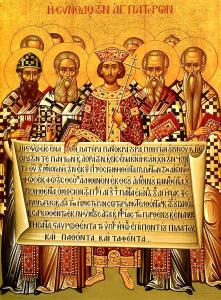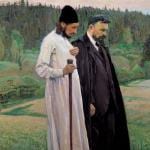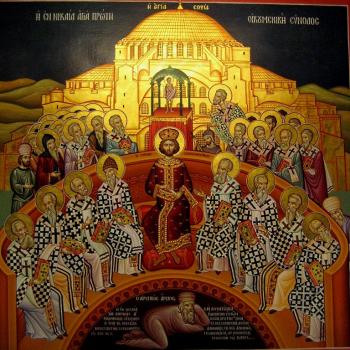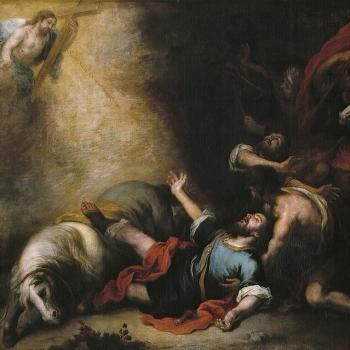
The First Ecumenical Council, the Council of Nicea in 325 CE, became understood as an Ecumenical Council only long after it had been convened and its declarations had been promulgated throughout the church. The fathers who were there understood the council to be significant, and its declarations to be authoritative, but they did not know that they would be starting a precedent which would be employed for other divisive questions in the church:
The fathers of Nicea did not call their assembly “ecumenical”; rather, they often used the expression “great and holy council.” They had, however, the unquestionable awareness of representing the moral consciousness of the whole Church; this was clearly shown by the ending of the symbol of faith they worked out. Eusebius of Caesarea was the first to call the Council of Nicea, “ecumenical.” It is proper to note that not until later did the term “ecumenical council” receive specific acceptance by being exclusively applied to a very definite type of church assembly. [1]
The fathers of Nicea wanted to find the best way to proclaim what they believed. This, they believed, would help bring together Christians throughout the world as one. They knew they had to demonstrate to the world that Christians held a common faith, one with another. But that was not an easy thing to do. People, with different linguistic and philosophical backgrounds, had to deal with the various conflicts those difference established. This meant they had to discern which ways the common faith could be expressed and held and which ways went beyond the common bond and needed to be repudiated. And though Constantine initiated the council, and actually engaged discussions in it, he wanted Christian leaders to establish answers for themselves. Despite what some might have later suggested, he did not force his own opinions on the conciliar decree (even if, later, his actions might have changed), as Archbishop Peter L’Huillier writes:
Constantine took an active part in its debates, but there is no evidence of his voting at the Council of Nicea; he only confirmed the decisions of the bishops and made them binding under Roman law. Conciliar procedure thus modeled on that of the Senate enabled the Church to safeguard a certain independence in all matters of doctrine by encouraging the emperor to work through assemblies of bishops to achieve a unity of belief. [2]
Thus, when Christians were confronted with the Arian crisis, they knew they had to find a way to proclaim divinity of Christ while acknowledging the distinct personalities of the Father and Son. They wanted to acknowledge monotheism without falling into the various Christological errors which the church had previously encountered, such as the error of Paul of Samosata. But this did not mean they did not learn from what Paul, or others, had said. Paul of Samosata famously introduced the term, ὁμοούσιος, homoousios, into Christian discussions.
Paul had used the word ὁμοούσιος to describe the relationship of the Father and Son as being one and the same substance as well as denying a diversity of persons between the two. Yet, he distinguished Christ from the Father through an adoptionist Christology. He believed that the man, Jesus, was indwelt with the Holy Spirit of God (which was of one undifferentiated substance). The Logos was seen more as the rational element of the Father instead of being understood as a divine person in his own right. As a result of how he used it, the word ὁμοούσιος was repudiated at a Synod in Antioch when Paul’s teachings were condemned.
The fathers of Nicea, especially Ossius of Cordova and Alexander of Alexandria, rejecting Paul of Samosata, nonetheless saw the word ὁμοούσιος could be interpreted in a new, different way. It could help serve them as they wanted to establish the equality of the Father and the Son. They are not to be differentiated in their substantial being or essence, though are to be distinguished according to their personal qualities or relations. The term ὁμοούσιος did not have to be read as a denial of the personal relations. It should not be surprising, however, that those who fought against Nicea, especially the Nicene Creed, attacked the word, saying that it was already rejected by the church and implied heresy.
Whatever words are used to describe God, especially whatever words are used to describe some of the greater revealed mysteries of God, like the Trinity, will all be problematic because words cannot properly capture the reality of God. They can point to the truth, but in all their uses, there will be questions as to how they are to be interpreted. This means there will always be some level of ambiguity or vagueness whenever God is being discussed.
Many might be surprised to learn that the word ὁμοούσιος is riddled with troubles because of the long history of its use over the centuries has given it various interpretations which we automatically apply to it when we hear it or use it (or its translation). They do not know the other ways it can be, and has been, interpreted. Nonetheless, at the time of Nicea, the vagueness of the word was quite apparent, as St. Hilary of Poitiers would note in his writings while explaining that “ὁμοιούσιον,” (of like substance), which was suggested as its alternative, was likewise ambiguous, and indeed, more troubling:
But you say: ‘The ambiguity of the word ὁμοούσιον troubles and offends me.’ I pray you hear me again and be not offended. I am troubled by the inadequacy of the word ὁμοιούσιον . Many deceptions come from similarity. I distrust vessels plated with gold, for I may be deceived by the metal underneath: and yet that which is seen resembles gold. I distrust anything that looks like milk, lest that which is offered to me be milk but not sheep’s milk: for cow’s milk certainly looks like it. Sheep’s milk cannot be really like sheep’s milk unless drawn from a sheep. True likeness belongs to a true natural connection. But when the true natural connection exists, the ὁμοούσιον is implied. It is a likeness according to essence when one piece of metal is like another and not plated, if milk which is of the same color as other milk is not different in taste. Nothing can be like gold but gold, or like milk that did not belong to that species. I have often been deceived by the color of wine: and yet by tasting the liquor have recognized that it was of another kind. I have seen meat look like other meat, but afterwards the flavour has revealed the difference to me. Yes, I fear those resemblances which are not due to a unity of nature. [3]
And so, in his writings, Hilary explains that the teaching of Nicea used what he believed was the best word possible to delineate the equality of the Father and the Son. But he also recognized that it always has to be properly interpreted:
Here the Holy Council of religious men introduces no prior substance divided between two Persons, but the Son born of the substance of the Father. Do we, too, deny or confess anything else? And after other explanations of our common faith, it says, Born not made, of one substance with the Father (which in Greek they call ὁμοούσιον). What occasion is there here for an erroneous interpretation? The Son is declared to be born of the substance of the Father, not made: lest while the word born implies His divinity, the word made should imply He is a creature. For the same reason we have of one substance, not to teach that there is one solitary divine Person, but that the Son is born of the substance of God and subsists from no other source, nor in any diversity caused by a difference of substance. Surely again this is our faith, that He subsists from no other source, and He is not unlike the Father. Is not the meaning here of the word ὁμοούσιον that the Son is produced of the Father’s nature, the essence of the Son having no other origin, and that both, therefore, have one unvarying essence? As the Son’s essence has no other origin, we may rightly believe that both are of one essence, since the Son could be born with no substance but that derived from the Father’s nature which was its source.[4]
The fathers of the Council of Nicea had to deal with a terrible theological problem. They had to find the best way to affirm the equality of the Son with the Father. They were not merely similar to each other, for just focusing on such similarity would suggesst substantial differences between the two. They had to be seen as absolutely equal, distinct in personage (with the Father begetting the Son). Nonetheless, in presenting this truth, any and all forms of polytheistic interpretation of the personages of the Trinity had to be denied. They came up with the term ὁμοούσιος to do this. Despite the way it had been previously interpreted, they knew it could effectively do what they wished, to point to the truth, but they also had to do so accepting that it could be interpreted in other ways, meaning some ambiguity would necessarily be involved in their theological definition.
By the nature of human language, then, when dealing with the great, transcendent mysteries of God, the words which we use to suggest those mysteries will be liable to misinterpretation. They will all contain elements of ambiguity about them. We must recognize how they point to the truth, but not try to limit the truth according to the most literal approach to the words themselves. We must discern what is intended by them, instead of quickly dismissing them if we can find poor, indeed, flawed interpretations of them.[5] Likewise, the ambiguity which allows for such flawed interpretations must be recognized, and seen as an important feature of theological language, because it is only by having such a fluidity will we stop trying to trap the mystery of God with words. We should make words, through our interpretation, follow the truth, rather than the reverse, as Al-Ghazālī explains:
One who considers the realities of the words may become bewildered by the multiplicity of the words and imagine many meanings. But one to whom the realities are unveiled will make the meaning a root and the words a follower. This situation is reversed in the weak, since they search for the realities from the words.[6]
Thus, at the Council of Nicea, the Son was glorified by the fathers of the Council by instituting a Creed. When that Creed is properly interpreted properly, it proclaims the glory of the Father and the Son, the glory which they share in common. It expresses the glory which Jesus prayed about before the passion: “and now, Father, glorify thou me in thy own presence with the glory which I had with thee before the world was made” (Jn. 17:5 RSV), for that glory is the Divine glory, the glory which existed before the world, and so before time itself. The glory of the Son is eternal, and through his mission in the incarnation, the Son manifested that glory in the world. He wanted it to be manifest in and through his human nature so that we could see that glory and realize it was his, personally, and not something which he received by adoption.
The fathers of the Council of Nicea understood the need to properly present the glory of the Son to the world. They knew it was not an easy task. They knew they could describe it, point to it, but they also realized it was only those who followed through with their pointer to the mystery which lay beyond what they said could and would properly acknowledge the Creed. They established the way we can and will speak of the glory of the Trinity, showing that we can and will use human terms to do so. We must not be confused or upset when we do so just because our words can be misinterpreted by others. We do not have to be upset with ambiguity, but this is only because we realize the words are meant to serve the truth and not to construct or create it by themselves.
[1] Archbishop Peter L’Huillier, The Church of the Ancient Councils (Crestwood, NY: St. Vladimir’s Seminary Press, 2000), 18-19.
[2] Leo Donald Davis, The First Seven Ecumenical Councils (325 -787). Their History and Theology (Collegeville, MN: Michael Glazier Book, 1990), 57.
[3] St. Hilary of Poitiers, “On the Councils” in NPNF2(9): 28.
[4] St. Hilary of Poitiers, “On the Councils,” 26-7.
[5] The debate over the filioque represents what happens when this is forgotten.
[6] Al-Ghazālī, The Niche of Lights. Trans. David Buchman (Provo, UT: Brigham Young University Press, 1998), 26.
Stay in touch! Like A Little Bit of Nothing on Facebook.
If you liked what you read, please consider sharing it with your friends and family!












